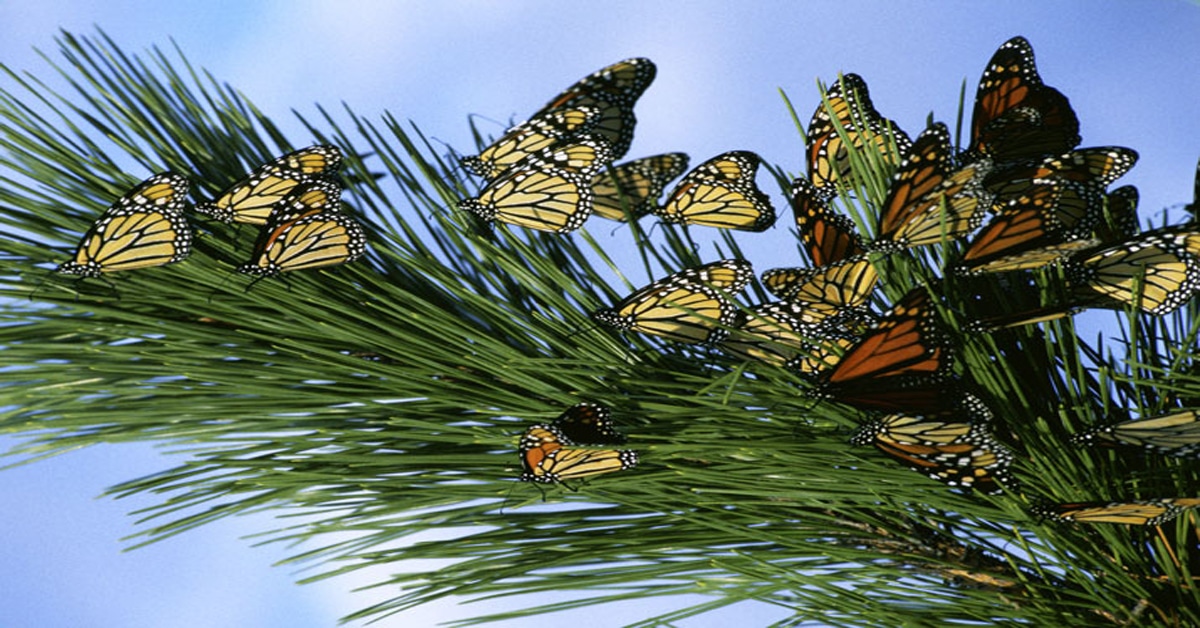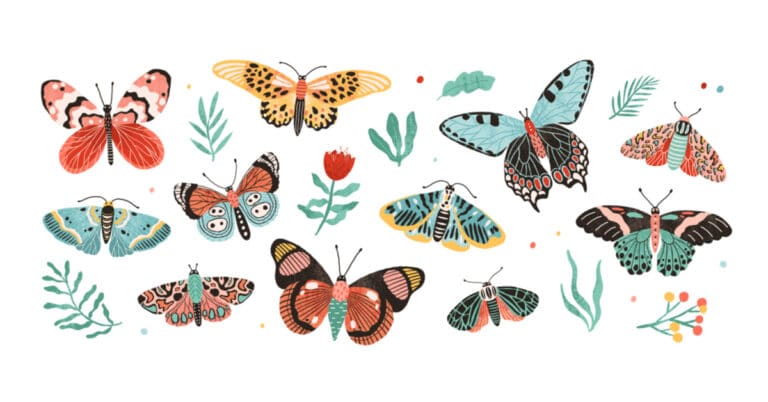Monarch Butterfly Migration
When they are active, Monarchs like plenty of space. When they are about to hibernate, they opt for safety in numbers. Clusters of twenty or thirty butterflies weigh down the thin tips of tree branches and become a positive tourist attraction.
Where do Monarch Butterflies migrate to?
The Monarch Butterfly migration map is pretty simple. From points east of the Rocky Mountains, the butterflies cross the Gulf and hibernate in Mexico, in oyamel fir trees. From points west of the Rocky Mountains, they hibernate in southern California, in eucalyptus trees.
Places advertising the opportunity to see hundreds of Monarchs all in one place, which is seldom possible in most places, include Pacific Grove, Pismo Beach, Santa Cruz, California, and the Monarch Butterfly Biosphere Reserve, Michoacan. After seeing pictures of this spectacle in advertisements or on the Internet, many people want to add a selfie to their butterfly photo collections. Towns and cities that make this easy can look forward to seasonal economic boosts from butterfly tours.
Why?

There are two obvious reasons why Monarchs migrate. In September and October, most of the places where they live start to become too cold for them. Butterflies are cold-blooded and die when temperatures drop low enough that water will freeze. (At temperatures between 33 and 60 degrees Fahrenheit, or 0 and 15 Celsius, all butterflies will eventually go into a dormant state, though Monarchs are the only North American species that can hibernate through the whole winter.
By positioning their wings in direct sunlight, pumping their wings, and shivering, butterflies sometimes get themselves off the ground on a chilly day. They are most active at 20 to 25 degrees Celsius.)
Then, in February and March, when the butterflies start to wake up, the food plants they need are not available in the places where they hibernate, so they go home again. At least they try.
Other North American butterflies survive the winter as eggs or pupae, but only the Monarch Butterfly’s life span allows it to survive the winter as an adult butterfly. Most Monarchs hatch, and live their whole lives, during the warm season; they live three or four months altogether, about half of that time in their adult form. The ones who hibernate can live twice as long as the ones who do not, by sleeping the winter away.
Unusual weather can have drastic effects on hibernating Monarchs. Their instincts guide them to places where their metabolic rates will slow down just enough to allow them to fly back north and find food, in a normal winter. During a cold spell, they may freeze. During a warm winter, they may metabolize too much-stored fat too fast and become unfit for the return flight.
Is the migration behavior of the Monarch Butterfly really changing in response to global warming?

It’s good to know that Barbara Kingsolver’s popular novel, Flight Behavior, was pure fiction. (So was Joan Aiken’s Butterfly Picnic, which invented a whole new fictional butterfly species’ a sort of cross between Monarchs, a kind of tiger moth found in Europe, and some sort of giant tropical species found in Africa.) Butterfly groves still exist in Mexico and California. Monarchs have been found hibernating in the same individual trees where a great-grandparent hibernated, but when trees die, the butterflies find other trees.
Briefly, the facts about Monarch Butterfly migration are awesome enough that they have sometimes been reported in misleading ways. Most individual Monarchs never migrate. Many of those who do migrate fail to complete the migration. Some are blown off course and land in places they never intended to go.
Some migrate only far enough to find warm temperatures; these individuals may or may not go into hibernation, and may or may not survive the winter, in places like Tennessee or Florida. Probably a few Monarchs hibernated in Virginia long before Virginia received its current name. Descriptions of animal migration behavior are based on what the most successful individuals do, so they will not accurately describe every single butterfly you see flying south in October.
Many things can go wrong along the Monarch Butterflies’ migration path. For many years, the main dangers were to individual butterflies. Some butterflies who attempted migration might simply have been too old when they started the journey. Some were eaten by birds or struck by cars. Some might have stopped for a sip of nectar from a freshly sprayed flower. In the twentieth century, children who probably weren’t allowed to handle cameras used to try to collect butterflies by killing them and pinning their actual bodies to boards.
And almost every year, somebody found a stray Monarch who had obviously been trying to get to Mexico spending the winter in some part of Britain, instead. (Monarchs are not really a British butterfly, but enough of them land in Britain that they’ve been listed in British field guides.)
Today, habitat changes are putting some Monarch populations on locally endangered species lists. Monarch Butterfly extinction has become something people can imagine. It is important to understand that all of the contiguous United States, most of Canada below the Shield, and most of Mexico are Monarch Butterfly habitats for at least part of the year.
What is the meaning of declining numbers of migrating Monarchs?
Variations from year to year have been nothing to worry about. However, a steady decline like the one we’ve seen in the present century could become irreversible.
At the time of writing, Monarchs are still abundant in most of North America…but they’re less abundant than they used to be. Several factors threaten Monarch Butterfly populations: habitat destruction, climate change, and pesticide pollution and there’s some reason to fear that trusting human efforts to restore population levels might wipe out the species, too.
(How is that possible? Monarchs are big and hardy enough that it’s easy to raise a few of them in captivity. Though not cuddly or affectionate, they can be interesting pets. However, large-scale efforts to domesticate Monarchs could potentially destroy biodiversity, breed in weaknesses, and encourage predators. Ecologists warn that nobody should try to raise more than a hundred Monarchs at the same time. If you want to release a crowd of butterflies at a special event, consider a mixed group. A quick Internet search for phrases like the yellow monarch butterfly and blue monarch butterfly confirms that many confused people think all big showy butterflies are Monarchs anyway, although they’re not.)
Is there a great documentary movie about Monarch Butterfly migration?

Many people agree that Flight of the Butterflies is a great documentary movie. It tells the story of how Fred Urquhart spent his career tracking Monarchs’ migration paths.
There are groups that collect money to save important trees and educate people about monarch conservation. You can learn more about helping monarchs here.

Having discovered a fondness for insects while pursuing her degree in Biology, Randi Jones was quite bugged to know that people usually dismissed these little creatures as “creepy-crawlies”.






